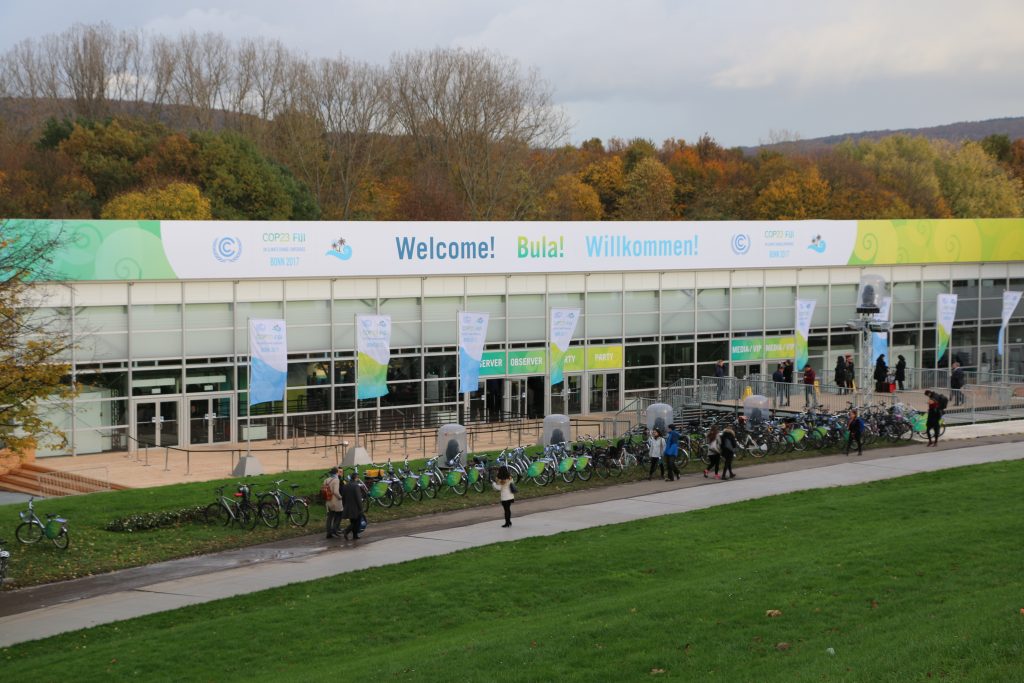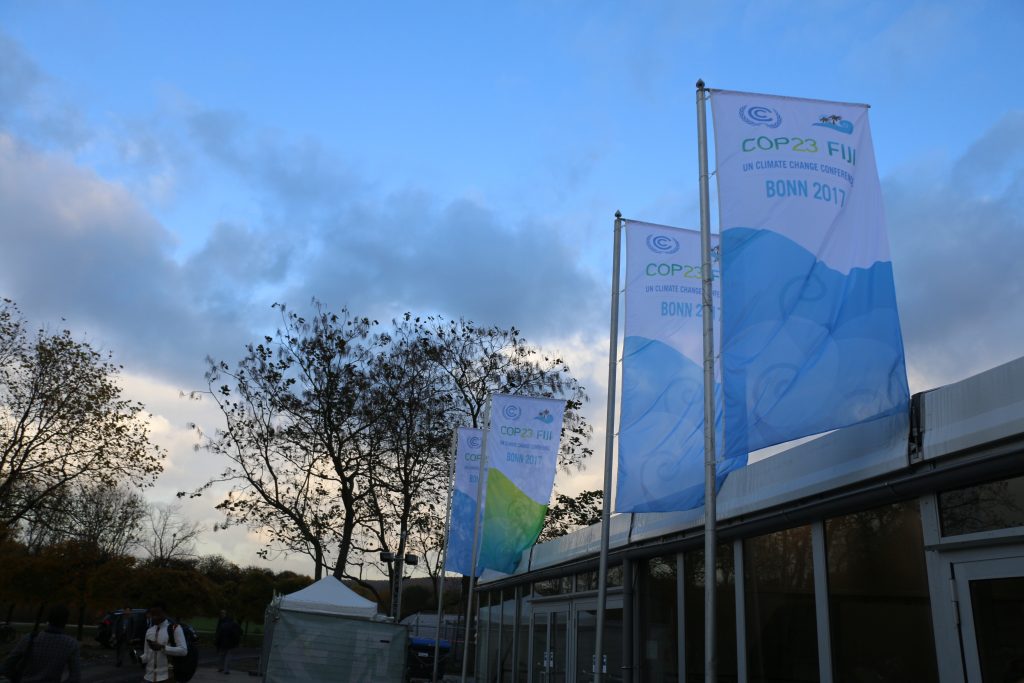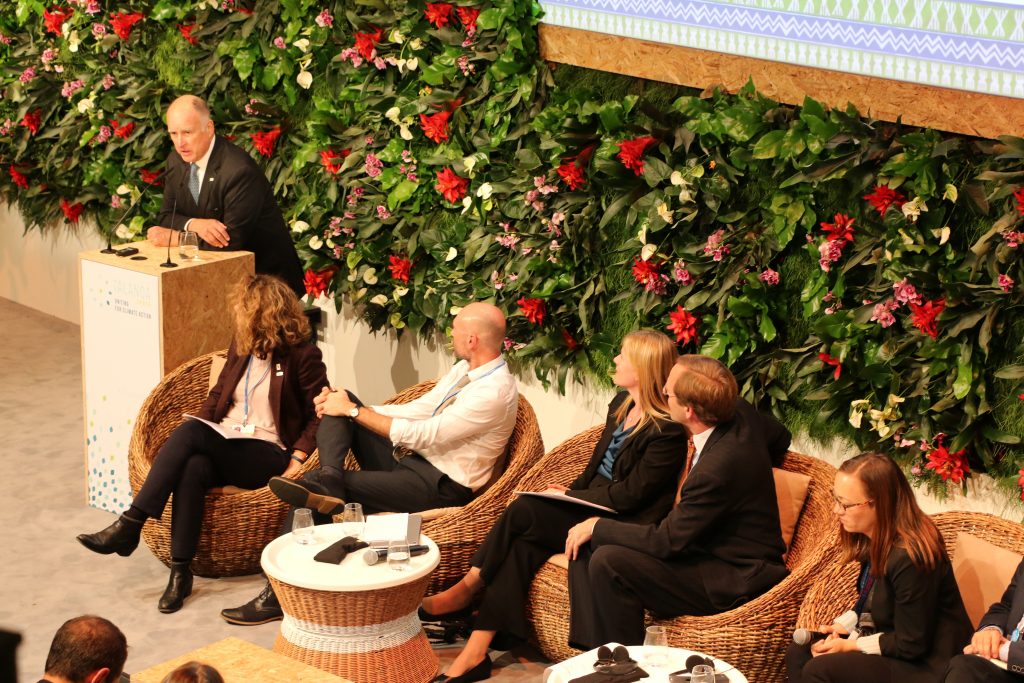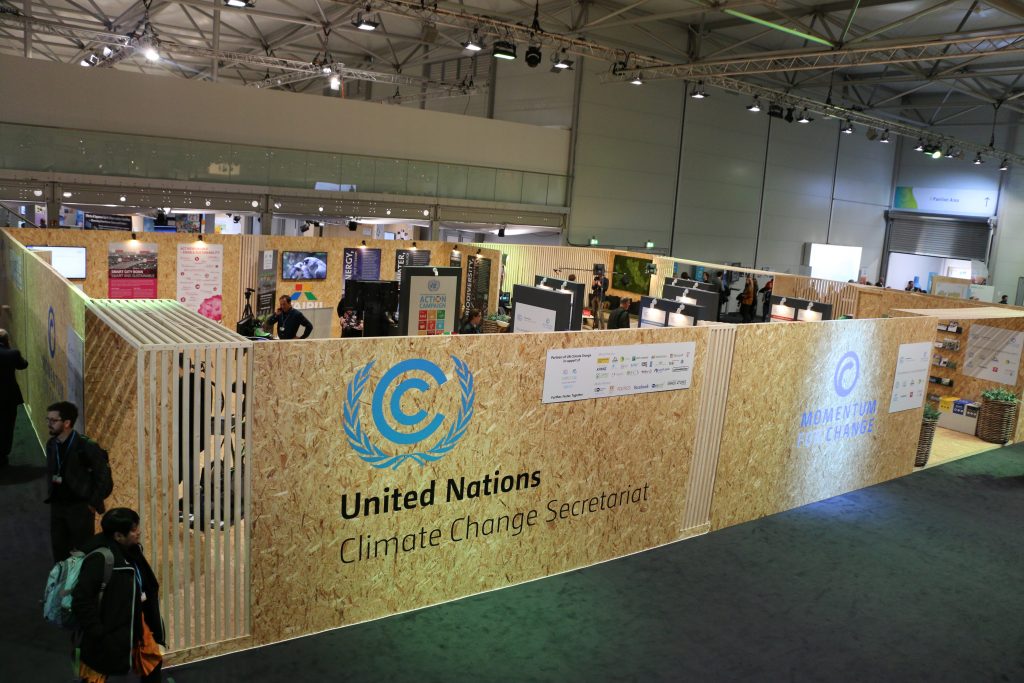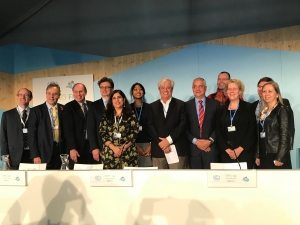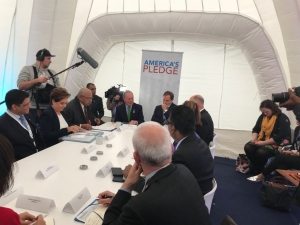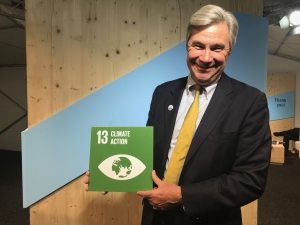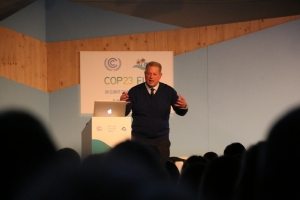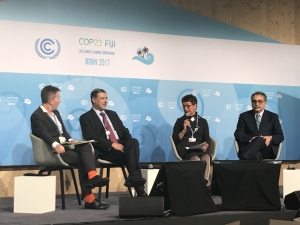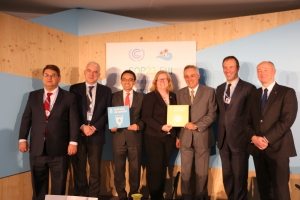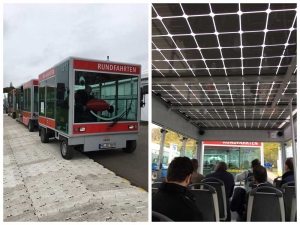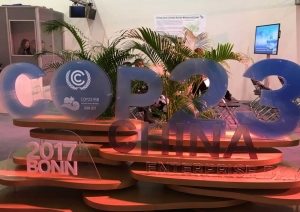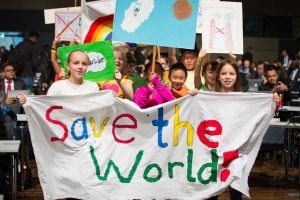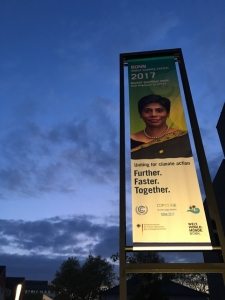BULA! That’s the Fijian word for “welcome.” So, bula to Bonn and bula to our live blog of the UN Climate Change Conference, also known as COP23, which is taking place in Germany from 6 to 17 November 2017.
For the next two weeks we will be sharing highlights here from the heart of the conference. You can watch all the proceedings live from here: https://unfccc.cloud.streamworld.de/live, and stay up to date with all of the Department of Public Information’s COP23 coverage here: https://www.un.org/sustainabledevelopment/cop23/.
_____
Day 12: Friday, 17 November:
The Bonn Climate Conference and the Sustainable Development Goals
The Bonn Climate Conference produced many new climate action initiatives, commitments and partnerships. Announced by governments, business and civil society representatives, the announced actions cover many of the areas covered by the Sustainable Development Goals—such as energy, water, agriculture, oceans and coastal areas, human settlements, transportation, industry, and forests. Climate finance and climate resilience were also at the center of the discussions at the conference.
Sometimes it seems that climate change is its own issue that is being addressed in its own forum, quite separate from other issues, such as eliminating poverty, promoting prosperity, gender equality and human rights. Often, it is the big geopolitical stories that dominate the headlines, such as the impacts of the US announced intention to withdraw from the Paris Agreement, but often hidden from view is that the world is moving to take climate action. Climate action is often disguised as action in other areas as well, so we thought we would walk through the Sustainable Development Goals to see what we picked up on new trends and thinking.
Goal 1—No poverty—Climate change, without a doubt, is having the biggest impact on the poorest. In Bonn, greater attention was paid to the connection between climate change and the increasing numbers of climate refugees and migrants who are moving due to water scarcity, land degradation, depleted fisheries, and conflicts, all exacerbated by climate change. There is also a major focus on the most vulnerable, who suffer the most from the increasing number of extreme weather events. A major insurance initiative to help the most vulnerable received a boost here in Bonn. There was also a greater awareness of the need to link national climate plans with national sustainable development plans.
Goal 2—No hunger—Climate change is increasingly impacting food security—production of key staples around the world is declining– and agriculture was a major action area in Bonn. As demand for food is up around the world, largely driven by population growth, there are increased efforts to help farmers produce more food creating while less greenhouse gases. Agriculture accounts for about a quarter of all emissions. Consequently, there was an emphasis in Bonn on “low-carbon livestock,” improving soil conditions, reducing waste, and reducing meat consumption—and bringing new techniques and information to poor rural farmers. The Conference addressed areas of action on soil, livestock, nutrient and water management, adaptation and on the food security and socio-economic impacts of climate change across the agriculture sectors.
Goal 3—Good Health and Well-being—Actor and former California Governor Arnold Schwarzenegger was the most visible messenger on the climate-health connection, focusing on the World Health Organization (WHO) reports that show that air pollution causes more than six million premature deaths every year. The solution to air pollution corresponds to the solution for reducing emissions: reduce use of fossil fuels, and switch to cleaner cooking fuels. Another health issue that figured prominently in discussions in Bonn included the growing threat of vector-borne diseases, such as the Zika virus.
Goal 4—Quality Education—While the SDG goal is about all education, the Bonn Conference focused on the need for more climate education. Education Day here focused on the growing integration of climate awareness into curricula, as well as the need for greater science literacy and an understanding of the science of climate change.
Goal 5—Gender equality—After years of negotiations, countries agreed on a Gender Action Plan, a plan that calls for greater focus on issues of concern to women, and to ensure that more women are part of the process that historically has been male dominated. Still, while gender issues were mainstreamed into a wide range of events, many of the hundreds of panel discussions that took place at the Conference were still dominated by men .
Goal 6—Water and Sanitation–The majority of national climate plans with an adaptation component which have been submitted under the Paris Climate Change Agreement prioritize action on water, yet financing would need to triple to 255 billion euros (about USD295 billion) per year to meet such targets. Water tends to be a local issue but consequences of its unwise management have global impact. Around 40% of the world’s population will face water shortages by 2050, accelerating migration and triggering conflict, while some regions could lose up to 6% of their economic output, unless it is better managed. The European Investment Bank announced that they will provide US $75 million for a new US$405 million investment programme by the Water Authority of Fiji. The scheme will strengthen resilience of water distribution and wastewater treatment following Cyclone Winston, the world’s second strongest storm ever recorded, which hit Fiji in February 2016.
Goal 7—Affordable Clean Energy—Discussions on energy dominated the Conference. The news is mixed, with the use of renewable energy continuing to grow, and investments in renewables continuing to far outpace investments in fossil fuels, particularly in developing countries. Renewables are also having a greater impact in communities not served by the grid, and is replacing kerosene-lamp lighting in places like Kasese, Uganda. But fossil fuel use is still rising—and are causing emissions to rise this year after holding steady for three years. Ending, or at least sharply reducing, the use of coal continues to be a major objective for many NGOs, and many governments as well. Brazil and 18 other countries launched an initiative to promote clean biofuels in Bonn.
Goal 8—Decent Work and Economic Growth—For a long time, and even today, there is an argument that taking action on climate change would wreck the economy and cost jobs. But the opposite is happening, as countries have found that they could decouple economic growth from more intensive fossil-fueled use. More job opportunities are now in renewable energy than in fossil fuel, and countries—and local governments—used Bonn to show how there are greater economic opportunities in the green, low carbon economy.
Goal 9 – Industry, Innovation and Infrastructure—Greening infrastructure is a major area where action can reduce emissions. Buildings, in particular, are a major source of emissions and greening buildings has been a major focus of discussions here in Bonn. Transportation, which is responsible for 12 percent of global emissions, had its own day here in Bonn. The Conference itself employed a fleet of electric buses, shuttles, electric cards, and bicycles (the quickest way between two points here), emphasizing the need for sustainable transport. The focus of discussions here was on the decarbonization of the transport sector.
Goal 10—Reduced inequalities—One of the hallmarks of the negotiations over climate change is the inherent inequalities between rich and poor, developing and developed countries, and those who are most vulnerable to the impacts of climate change, including women, persons with disabilities and indigenous people. Much of the work on building resilience discussed in Bonn, including initiatives on insurance, are aimed at assisting the most vulnerable.
Goal 11–Sustainable Cities and Communities – The role of cities and communities as major actors in climate efforts continued to grow in Bonn. Urban areas account for around two-thirds of the world’s greenhouse gas (GHG) emissions from global energy use. Their overall contribution to total greenhouse gas emissions is estimated at between 37% and 49% globally, depending on base assumptions of data used. Industry sectors connected to human settlements have a major impact. Buildings, for example, are responsible for some 40% of global GHG emissions yet are an essential element for countries to achieve their NDCs. 132 of the NDCs submitted explicitly mention the building sector. If these NDC pledges were achieved in addition to existing action, about 60% of buildings-related CO2 emissions would be covered. However, nearly one-third of NDCs mentioning buildings do not indicate specific actions on how to achieve their ambition.
Goal 12 – Responsible consumption and production—It’s fundamental that to make the point about being green, you have to walk the talk. COP23 in Bonn is the first UN Climate Change Conference to receive official certification for eco-friendly performance. All goals and measures were documented in the environmental statement, then assessed on-site over several days by environmental verifiers and subsequently validated. Such measures included waste avoidance and strict waste separation, climate-friendly catering, excellent local public transport, climate-neutral shuttle services and environmentally sound and reusable materials also for the temporary structures. Energy supply and water consumption are also among the areas to be reviewed in the follow-up.
Goal 13—Climate Action—That’s what the Bonn conference was all about.
Goal 14—Life Below Water–The role that oceans play in climate change rarely receives top billing, but with a COP president from a small island developing country, that changed in Bonn. Oceans, after all, absorb most of the excess carbon dioxide generated by emissions, and have been subject to warming, rising sea levels, loss of biodiversity, acidification, and coral bleaching. The Fijian Presidency proposed the Ocean Pathway that calls for affirming the call for action from the UN Ocean Conference, calls on countries to insert oceans into their national climate plans, making oceans a UNFCCC agenda item, and mobilizing resources for ocean action.
Goal 15—Life on Land—There were two main areas of focus in Bonn that relate to this Goal, on reducing deforestation and preventing land degradation. Last year, forests equal to the size of New Zealand disappeared. In Bonn, initiatives from Ecuador, Gabon, Walmart and Mars Inc. were announced that included An Ecuadorean initiative to reduce 15 million tonnes of CO2 emissions in the forest sector, and a commitment to deforestation-free commodities by Walmart. Mars Inc. announced a new policy to reduce their carbon footprint 27% by 2025 and 67% by 2050 by addressing deforestation throughout their corporate value chain.
Goal 16—Peace, Justice and Strong Institutions—Climate change is playing an increasingly destabilizing role, as intensified droughts and floods are changing the landscape, and with major ecosystems disintegrating—such as the disappearance of much of Lake Chad, more people are on the move. Climate justice has been a major topic of concern, articulated mostly by civil society. But more countries are recognizing the need to build strong institutions as they develop their national climate plans—NDCs—and national plans to meet the SDGs.
Goal 17—Partnerships for the Goals—One of the most oft-repeated phrases delivered at the Bonn Conference was that governments cannot address climate change on their own. They require the involvement and engagement of civil society, business and finance. Building partnerships is at the core of the action agenda and fair amount of activity at the Bonn Conference involved groups of participants meeting in hallways discussing plans to move ahead.
- Photo: UNFCCC
- Cultural event at COP 23. Photo/DPI
- Gender day at COP 23. Photo/DPI
- COP zone. Photo/DPI
- Green bikes. Photo/DPI
- Solar powered shuttle between conference zones. Photo/DPI
- Country pavilions Photo/DPI
- Fijian cultural performers Photo/DPI
_____
Day 11: Thursday, 16 November:
An Implementation COP—The Bonn Climate Conference has been discussed as a roll-up-your-sleeves kind of COP. It has been described as an implementation COP where decisions are being made on the nitty gritty details that will determine how the climate process is moving forward. Now that the Conference is winding down, it appears that parties are heading toward agreement.
Ecuador, which is representing a group of 134 developing countries, reported progress on many of the outstanding issues in the negotiations. Lead negotiator and Ecuadorian Minister of Foreign Affairs and Human Mobility María Fernanda Espinosa said progress had been made on the creation of the platform for indigenous peoples to exchange knowledge and practices regarding adaptation that would start in 2018. Progress had also been made on the issue of loss and damage, which refers to people who are faced with situations where adaptation is no longer possible.
Areas where progress has been less than stellar center on the means of implementation. Developed countries had promised that they would ramp up climate financing to US$100 billion a year by 2020. Developing countries, however, are not seeing many signs that this money will materialize. Another sticking point during the COP, revolved around commitments made for the period prior to2020. Remarking that it was the 20 year anniversary of the adoption of the Kyoto Protocol, she said “no one is talking about Kyoto. We haven’t had its birthday party yet”.
Not a sunny COP—It was gray and drizzly for days, but the sun finally did emerge for short spurts. The emerging science on climate change has also cast a shadow: emissions are rising again after staying flat for three years. Concentrations of carbon dioxide in the atmosphere are at an all-time high, and global temperatures are continuing their upward march. But against all this news, there is an air of steadfast optimism about the realistic solutions out there, that can help us address climate change.
The reasons for optimism: For one, there is no shortage of sunshine in most of the world and the prospects for solar energy appear unlimited. With progress on storage batteries, renewable energies could continue their exponential growth. Renewables, right now, represent a small but developing energy sector, growing by 5.4 percent every year. Although still relatively small in the big picture, scientists here in Bonn contend that this kind of growth will lead to a sharp upward swing in the use of renewables.
The International Energy Agency, which maps these trends, says in 2016, growth in solar photovoltaic capacity was larger than for any other form of generation, and that since 2010 costs of new solar PV have come down by 70%, wind by 25% and battery costs by 40%. It also found that there was a growing electrification of energy: in 2016, spending by the world’s consumers on electricity approached parity with their spending on oil products.
The road ahead – And already people are looking at the road ahead: UN Secretary-General António Guterres laid out the path forward during his speech to the opening of the high-level segment on Wednesday, where he stressed the urgency for increasing ambition on climate change. He listed five ambition areas: emissions, adaptation, finance, partnerships and leadership. These areas will find a thread through the One World Summit in Paris next month to the California Summit for non-party actors in San Francisco next September. Then there will be a pivotal COP Climate Conference in Katowice, Poland, and a Climate Summit in 2019 convened by the Secretary-General.
NGOs looking ahead – NGOs attending the Bonn Climate Conference are looking forward to making a difference right after the COP. Hoda Baraka of 350.org said “the science is clear, we know what we need to do, and we need governments stepping up and making real commitments.” Dyana Jaye from Virginia, USA said she got involved in climate action because she was so angry about the US announcement to pull out from the Paris Agreement, and is working to make climate change matter in the 2018 elections. “We need to make politicians stand with the people. “ Other NGOs are planning actions a round the world: here in the Rhineland in Germany, where the objective is to close local coal mines; as well as in the Philippines, where the fight is against coal—and action is being contemplated at the IMF meeting next year in Bali.
- COP23 High-Level Plenary, Secretary-General António Guterres (Photo: DPI / Ariel Alexovich)
- COP23 High-Level Plenary, French President Emmanuel Macron and German Chancellor Angela Merkel (Photo: DPI / Ariel Alexovich)
- COP23 High-Level Plenary, Secretary-General António Guterres with a boy from Fiji (Photo: DPI / Ariel Alexovich)
- Fijian cultural performers (Photo: DPI/ Karin Orantes)
- Group of French high school students at COP 23(Photo: Jerome Bernard)
- Bonn Zone (Photo: DPI / Ariel Alexovich)
- Bonn Zone (Photo: DPI / Ariel Alexovich)
____
Day 8: Monday, 13 November:
Today’s the start of the high-level week at COP23, and it’s noticeably more crowded in the Bula and Bonn Zones. Highlights of the day included events about climate finance and sustainable cities. As part of “Finance for Climate Day” at COP23, high-level representatives from across the sector highlighted their efforts to meet the goals of the Paris Agreement of keeping the average global temperature rise well below 2 degrees Celsius and as close as possible to 1.5 Celsius.
Photos of the day:
- The main entrance to the Bonn Zone of COP23, which is in a park. (DPI Photo/Ariel Alexovich)
- Flags outside the Bonn Zone at COP23 (DPI Photo/Ariel Alexovich)
- California Gov. Jerry Brown speaks on the urgency of climate action at the Talanoa space of COP23. (DPI Photo/Ariel Alexovich)
- The busy exhibition hall at COP23’s Bonn Zone (DPI Photo/Ariel Alexovich)
- The UNFCCC space at COP23’s Bonn Zone (DPI Photo/Ariel Alexovich)
_____
Day 7: Sunday, 12 November
Two words: The Terminator.
Arnold Schwarzenegger arrived at COP23 today to speak at a World Health Organization event about air pollution. He highlighted the 25,000 people who die every day as a result of its effects and called for a significant reduction in carbon dioxide emissions.
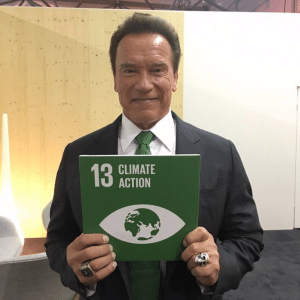
Arnold Schwarzenegger supports Goal 13 Climate Action at COP23. (UN Social Media/Karin Orantes)
_____
Day 6: Saturday, 11 November
Non-state actors—Just outside the perimeter of the COP—the zone under the jurisdiction of the United Nations—a tent called “America’s Pledge” brought together hundreds of COP23 participants determined to show that support for climate action in the United States was still strong at the national, state, and city levels. California Governor Jerry Brown said, “We’re doing real stuff in California. States have real power.” Former New York City Mayor Michael Bloomberg said the tent was the first of its kind and was inspired by the fact that this was the first COP where the US did not have a pavilion. He said the non-state actors who committed to climate action accounted for half of the US economy and would represent the world’s third largest economy if it were a country of its own. The non-state actors are requesting that they be more fully integrated into the COP process and show that they are taking real climate action. Brown said the group was releasing a report on progress so far “so the world can hold us accountable if we are going to avoid the worst impacts of climate change.
Demonstrators disrupted Brown’s speech, claiming that the governor was doing too little too slowly to eliminate fossil fuel automobiles and the production of fossil fuels. Referring to the demonstrators, Brown said, “This is very California.” He added that the eliminating 32 million vehicles overnight would lead to economic disaster. “We need to move from noise to real action. We need to move to decarbonization.”
Cities stepping up—Representatives of cities, settlements and urban organizations demonstrated their commitment to the Paris Agreement with the launch of new initiatives aimed at building better, more sustainable cities, including decarbonizing the construction sector. “There’s a movement afoot,” said Pittsburgh Mayor Bill Peduto, at COP23 promoting Climate Mayors, a growing group of US mayors who have pledged to meet Paris Agreement targets, or in the case of Peduto—exceed them.
Peduto said Pittsburgh, which once was a major steel producer, was a city with a future, and was now working to promote new technologies, including electric cars. “The next time you call an Uber in Pittsburgh, it might be a self-driving car. He added that “time goes in one direction. If you are waiting for mills to reopen, you will be left in the past. I have one message: Join us.”
Elsewhere, UN-Habitat Executive Director Joan Clos urged for better urbanization management at the launch event for the new global initiative Planners for Climate Action, which will brings together global, regional and national associations of urban planners to amplify their voice in building sustainable cities. We want to prevent urbanization from going too far down the wrong direction, he said.
Renewables in Kasese, Uganda—Kasese Mayor Godfrey Baluku Kime says his city is well on its way to meeting the goal of becoming 100 percent renewable by 2020. The city, which lies near snow capped mountains, relies heavily on kerosene to power households. It makes sense in Uganda, which he said receives 12 hours of sunshine a day, compared with Bonn, where he has yet to see the sun. So far, a programme has installed 17,000 solar panels, paid for by residents and the government. “It is important not too squeeze the resident,” he said, adding that the programme had generated income and had improved lives for people living in rural areas.
Halfway there—Whew! As Saturday comes to a close, we’re officially halfway through the COP. If we feel tired or stressed, at least there’s yoga in the India Pavilion.
- The French Pavilion features the Paris Agreement cafe. (DPI Photo/ Ariel Alexovich)
- UN-Habitat Executive Director Joan Clos poses after a discussion on urban planning. (DPI Photo/ Ariel Alexovich)
- UNFCCC chief Patricia Espinosa meets with Fiji Prime Minister Frank Bainamarama, UN Special Envoy for Climate and Cities Michael Bloomberg, and other officials on Saturday at COP23. (DPI Photo/Dan Shepard)
- US Senator Sheldon Whitehouse promotes Climate Action at COP23. (DPI photo/ Ariel Alexovich)
Watch our Facebook Live with pro-Paris Agreement US Senators.
Read our full Live Blog.
_____
Day 5: Friday, 10 November 2017
Climate action—The climate action agenda has firmly been part of the international dialogue on climate since the 2014 Climate Summit, and even before that, innovative solutions and ideas have been integral components of the climate conferences. Now that the Paris Agreement has been adopted, the action agenda has taken on a new urgency, as it encompasses all the work being taken to actually reduce emissions and build climate resiliency—and which help achieve the Sustainable Development Goals. Today, the Bonn Climate Conference looked at action on energy, agriculture, and water.
A view from above—It was while astronaut Thomas Pesquet spent 196 days at the International Space Station that he realized how fragile the world seemed. At first, he said, there is that awesome window on the world that “space view,” but on closer inspection, it was apparent how small and how connected everything was, and how much we need to protect the planet. In his luggage was a copy of the L’Accord de Paris”—the Paris Agreement, and he is now urging people to do even more to address climate change.
The inconvenience of it all—Al Gore has attended many climate conferences, and he visited the Bonn Climate Conference today with an updated message of urgency and hope that the world will move to achieve the goals of the Paris Agreement. “I’m gonna show you some slides. That’s what I do.” The fundamental question he asked was, “do we have to change,” and the answer was yes. Unprecedented heatwaves, floods, droughts, extreme weather and increasing numbers of refugees and migrants are starting to have political consequences. But he saw an emerging spirit around the world to tackle climate change, noting dramatic investment increases in renewable energy in countries such as Algeria, Chile and India. “We are approaching a moment in time. We are approaching a tipping point,” adding that the Bonn Conference needed to provide more momentum.
Investing in water–Global financing to prioritize sustainable water management must triple to US $295 billion per year to meet Paris targets, said representatives of the international water community who co-signed a “nature-based solution declaration” on Friday, the COP’s Water Action Day. As 40 per cent of the world’s population could face water shortages by 2050, what start as local water management issues have global impact as resources become scarce and migration accelerates. “Involving both women and men in decision making and integrated water resources initiatives leads to better sustainability, governance and efficiency,” said Mariet Verhoef-Cohen, President of the Women for Water Partnership, and Co-Chair of Water Scarcity in Agriculture Platform (WASAG).
Building national climate plans—Central to the success of the Paris Agreement are the nationally determined contributions—known as NDCs in climate speak parlance–of every country. But for many countries, putting these plans together, and then implementing them, requires assistance. That is why UNDP is devoting its space at the Bonn Climate Conference to discussions on the NDCs. And it’s not so easy. There are questions to be answered, what to invest in, whether, or how, to scale up certain initiatives, and what would be the financial requirements. UNDP experts say that governments are looking for “impact investment,” but determining what works best is sometimes counterintuitive. For example, investing in small scale clean energy renewable energy projects might not yield the greater emission reductions or income benefits—often investments in social development can yield far more value. In Burundi, it is estimated that a $50,000 development investment had delivered $181,000 in benefits, annually, in better health and employment.
- Former US Vice President Al Gore presents his latest climate change PowerPoint at COP23. (DPI Photo/Ariel Alexovich)
- COP23 participants are encouraged to use reusable water bottles and fountains can be found all over the conference centre. (DPI Photo/ Ariel Alexovich)
- A COP23 participant tries out a virtual reality display. (DPI Photo/ Ariel Alexovich)
- Mariet Verhoef-Cohen, President of the Women for Water Partnership, speaks at a panel at COP23 Friday about the links between water, climate, energy and agriculture. (DPI Photo/ Ariel Alexovich)
- Panelists from a water and energy discussion support Goal 6 and Goal 7. (DPI Photo/ Ariel Alexovich)
_____
Day 4: Thursday, 9 November 2017
The work of a COP—A climate conference operates on many levels — there are negotiations, discussions, presentations, press conferences, and exhibition — all aimed at advancing some aspect of the climate agenda. The negotiations themselves take place in a number of settings, ranging from small meeting rooms that allow countries to discuss the fine points at the working level, to larger plenary settings that involve all countries. The negotiations in Bonn are at the point where progress has been slowly made on the rules for implementing the Paris Agreement — the buzz word is about where all the issues land.
Action before 2020 — It really wasn’t envisioned that the Paris Agreement would enter into force so quickly — in less than a year after it was adopted. It was thought that the agreement would enter into force by 2020. Now, just two years later, 169 countries have joined. But a major area of negotiations has been left in limbo — the pre-2020 action agenda. Today, representatives from developing countries said this item needed to be restored to the agenda, citing the urgency for action before 2020 and the unfinished business of several previous COPs. This included the ratification of the Doha amendment to the Kyoto Protocol —which still survives, but after five years, has not entered into force.
Assessing the risk from climate change — It is not possible to say which country is suffering the most from climate change, but clearly, some are suffering more than others. According to the Climate Risk Index, released today from the NGO Germanwatch, a number of developing countries have had to endure repeated losses from storms. In 2016, Haiti, Zimbabwe and Fiji were at the top of the list, all slammed by major storms. They were followed by Sri Lanka, Vietnam and India. Taking a longer view, the hardest hit countries from 1997-2016 were Honduras, Haiti, Myanmar, Nicaragua, and the Philippines.
Joshua Wycliffe, Fiji’s Permanent Secretary for Local Government, Housing and Environment said, “we live in a world of change. Documents like the index provide us with a path on how we intervene.” He said when Tropical Cyclone Winston hit Fiji, half the population was displaced. “These storms can wipe economies off.
Climate smart farming — Farmers around the world are increasingly finding that their traditional ideas about when to plant and when to harvest are no longer valid. Climate change has altered the landscape and has asked academia for help in dealing with a whole host of new variables. That is why Cornell University developed some new tools for farming in a climate changed world. The new tools include a water deficit calculator, to help farmers plan or periods of low-rain. It also lets farmers know whether they need to invest in costly irrigation systems. There is a tool that allows farmers to plan when to plant cover crops—a few days difference makes a huge difference in yields. And there are tools to help farmers to increase energy efficiency and the use of renewable energy.
The University is also working with farmers in developing countries to improve yields and reduce loses to pests, droughts and pathogens. At present, the forecast is bleak for the total production of 9 out of 10 crops, unless the world employs better farming practices.
_____
Day 3: Wednesday, 8 November 2017
Adapting to climate change: Reducing carbon emissions is the part of the climate change discussion that gets most attention. But equally important is the need to adapt to a new reality. Climate change is happening, and the climate will continue to change, even if all emissions were eliminated tomorrow. A new UN assessment released today, the 2017 Adaptation Gap Report, finds that progress needs to be made towards assessing adaptation at the global level to meet the requirements of the Paris Agreement. The Agreement established the global goal on adaptation of enhancing adaptive capacity, strengthening resilience and reducing vulnerability to climate change, with a view to contributing to sustainable development and ensuring an adequate adaptation response in the context of the temperature goal.
The report explores the opportunities and challenges associated with assessing adaptation progress at the global level and recommends a framework is needed that can capture the big picture, what is changing, and be flexible as methods improve. The full report can be found at: http://www.unenvironment.org/resources/adaptation-gap-report
Fuel the size of a pineapple: There are several pineapples that adorn the ITER exhibit at the COP23 to demonstrate the amount of fuel which would power a huge multi-nation fusion energy project with no emissions and no radiation waste, and which is now underway in southern France. The functioning fusion reactor, working off a pineapple’s worth of fuel, would generate the equivalent of 10,000 tons of coal. The problem is that the 20 billion Euro fusion reactor, now under construction since 2009, will not produce any energy until about 2035.
Sustainable roads—Consider the environmental impacts of a paved road—while people and goods can move easier, the hardened surface prevents water from returning to the ground. That’s one reason why a company, Ding Tai Co., is showing off its roads in Bonn—showing that a paved road can breathe, reduce run-off, and recharge groundwater—purified, and reduce the heat-island effect that makes cities so much hotter than its environs.
- A paved road can breathe, reduce run-off, and recharge groundwater (Photo: UN DPI / Dan Shepard)
- A paved road can breathe, reduce run-off, and recharge groundwater (Photo: UN DPI / Dan Shepard)
Momentum—It seems that wherever you are, people are already looking at the next steps. In the case of climate change, the next step is the One Planet Summit, convened by French President Emmanuel Macron on 12 December. It will be, to the day, the two year anniversary of the adoption of the Paris Agreement, and will bring together world leaders. Next September, California will be hosting a conference for non-party stakeholders, then comes COP24 in Katowice, Poland, followed by the 2019 Summit that will be convened by the UN Secretary-General.
_____
Day 2: Tuesday, 7 November 2017
Indigenous peoples’ wisdom for climate adaptation – Indigenous peoples took center stage at the COP on Tuesday when they made a strong call to be part of the solution to climate change, emphasizing their traditional wisdom and practical knowledge about adaptation methods. “When we speak about sustainable development, we are looking after the management of our resources in a more orderly way,” said Janio Sangama, a member of the Kichwa tribe from the region of San Martin in the Peruvian Amazon rainforest.
An intention to join Paris—The list of countries joining the Paris Agreement has been growing quickly over the last year, but there were only two countries that had not signed the agreement—Nicaragua and Syria. That changed last month, when Nicaragua joined the Agreement and today, the Syrian representative at the COP intimated, in a plenary session, that Syria also intended to join. At the moment, 169 countries have joined the agreement and the list is growing. Click here for a full list.
Climate solutions—Exhibitions have typically been a mainstay of climate conferences. Companies use the COP to show new ideas and products, many governments have elaborate displays, and organizations raise their visibility. Now, with a greater focus of the conference moving toward action and results, many exhibitions take on greater importance, often showcasing the latest technologies and strategies to deploy in efforts to address climate change.
There are exhibits on fusion energy, smart roads, sidewalks that absorb less heat, sensors that provide an early warning system for flash floods. There are groups pressing for reducing meat consumption, forest preservation and organic farming. We’ll be visiting some booths in more detail later during these two weeks.
A sprawling COP—The distances are vast at the COP, which comprises two zones separated by 1.4 kilometers. The negotiations, the media center, and press conferences rooms are in one zone, named Bula, and exhibitions and side events are in the other, the Bonn Zone. It’s about a 20 minute walk or electric shuttle ride, or it takes about five minutes by bicycles, which are provided for free.
- Indigenous activist Rosalia Yampis Agkuash from Peru calls for climate action. (Photo: UN Social Media team/Karin Orantes)
- Electric shuttles running on 100% renewable energy help COP23 participants get around the climate conference venue. (Photos: UN Social Media team/Karin Orantes)
- China exhibition in the Bonn Zone. (Photo: UN Social Media team / Karin Orantes)
- Russia exhibition in the Bonn Zone. (Photo: UN Social Media team / Karin Orantes)
- India exhibition in the Bonn Zone. (Photo: UN Social Media team / Karin Orantes)
_____
Day 1: Monday, 6 November 2017
The conference kicked off with an opening ceremony that outlined the goals of the conference, presented with a certain Fiji touch. Here are some highlights of the day:
We need to do more—The world has moved on from the euphoric adoption of the Paris Agreement in 2015. Rather, participants of the conference came to Bonn with a clear understanding that the global situation demanded action. With reports showing that global levels of carbon dioxide concentrations were rising at historic rates, and that commitment so far would only take us a third of the way toward keeping global temperatures below two degrees this century, participants were solidly focused on next steps. COP23 President Frank Bainimarama, the Prime Minister of Fiji, issued a collective plea to the world to stay the course set in Paris. “We need more ambitious action. This is our moment of truth.”
The Fiji touch—There is no mistaking that this COP is not taking place in Fiji, although this is the first time that a COP president has come from a small island developing state. Yet Fiji managed to infuse the COP with a South Pacific touch, starting with a Fijian sailing ship in the lobby, then with an elaborate kava ceremony where a drink from the root of the kava plant was presented to the COP leaders. This is the second kava ceremony for the UN this year—there was one during the Ocean Conference in June. More substantively, Fiji has made the “Talanoa Dialogue” the centerpiece of its presidency, named for a Fijian storytelling tradition that builds empathy and trust as the basis for decision-making.
Warming up—For those who argue, or may think that the current trend of hot years is just a blip in the historical record, Petteri Taalas, head of the World Meteorological Organization (WMO), has some distressing news. The warming trend will continue for another 40 years, and will plateau then, an only then, if the world does something about curbing emissions. There is no hiatus: 2017 is among the three hottest years on record—2015 and 2016 were hotter due to the El Niño effect, but compared with the last non El Niño year—2014—it was hotter in 2017. Not all the world is affected in the same way. In fact, countries in the low latitudes and in the southern hemisphere saw their economies hurt by climate change, while some northern countries actually benefited from the warmer temperatures due to a longer growing period. Have a look at the Facebook Live with the WMO chief.
For the full report of the state of play of the world’s climate for the first nine months of 2017, see https://t.co/0jIx9rEOZA.
Scientists eager to join IPCC report—A major report from the Intergovernmental Panel on Climate Change (IPCC) is due in December 2018 on possible pathways to stay under a 1.5°C warming this century. Working on an IPCC climate change assessment report is not a paid job, IPCC head Hoesung Lee told the COP23 opening session that the Panel had received 7,500 nominations for the next assessment, double the number from the last report. “This will allow us to draw on a superb range of talent.”
- Children demand climate action at the opening of COP23 in Bonn. Photo: UNFCCC
- Fijian warriors performed a ceremonial welcome ceremony at the conference opening. Photo: UN Social Media
- The COP23 motto: Further. Faster. Together. Photo: UN Social Media Team
- COP23 leadership presides over the conference opening ceremony. Photo: UN Social Media
More COP23 coverage from the Department of Public Information
















